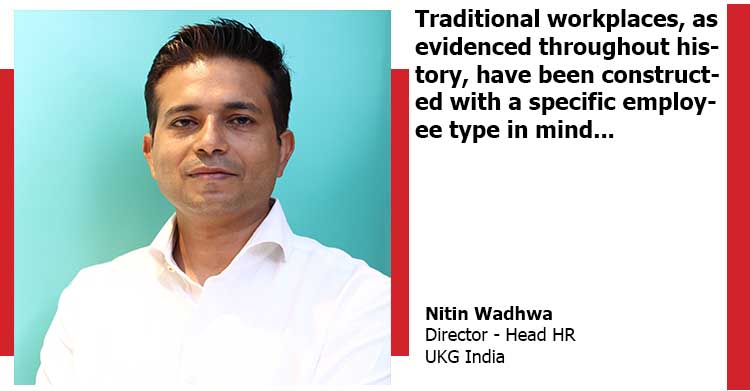The Role of ERGs in Driving Support and Inclusion for LGBTQIA+ Employees in the Workplace | Nitin Wadhwa | Director | Head HR | UKG India

Traditional workplaces, as evidenced throughout history, have been constructed with a specific employee type in mind. Individuals not completely fitting this bill have struggled with the pressure to conform to this restrictive idea of an ideal employee and have been riddled with prejudice and discrimination at their inability to do so. This harrowing experience of only bringing an ‘acceptable’ version of themselves to work have significantly alienated employees from diverse backgrounds such as those belonging to LGBTQIA+ communities. Moreover, the limited visibility and representation of diverse employees in leadership roles has further impeded their professional growth within the organization, directly impacting their retention and advancement opportunities.
However, as workplaces continued to evolve with time, certain modifications started being tailored into this idea of an employee. The global pandemic presented an opportune moment to wipe the slate clean, do away with existing norms that defined ‘work’ and ‘workers’, and shape up a new ‘future of work’. Notions such as flexibility, diversity, equity, and inclusivity, which had already been gaining currency in the emerging landscape of workplaces, were further accelerated by the shift to remote and hybrid work models. This transformation challenged the preconceived notions of an ideal employee and emphasized the importance of accommodating diverse talents, perspectives, and identities within the workforce.
ERGs: Soaring higher with a new approach for a new era of employees
Employee resource groups have roots in the Civil Rights era. Originally called workplace affinity groups, they were first formed in 1964 at Xerox for Black employees who still faced discrimination on the job. Conceived with the objective of bringing together underrepresented employees who share certain characteristics, ERGs are emerging to becoming powerful resources for facilitating discussions and providing networks for professionals based on shared identities, experiences and allyship. The existence of these groups have enabled diverse employees in the workforce to share their experiences in a safe space and be their full authentic selves without the fear of judgement. In the past few decades, companies have expanded ERG topics and begun implementing chapters worldwide, and today, ERGs are integrated into business strategies as imperatives.
Over the years, consistent employee engagement with the help of ERGs have enabled organisations to implement necessary changes in their policies and workplace infrastructure in order to accommodate LGBTQIA+ employees. Knowing the social stigma around the community that most do not get support from home to the extent that they are also disowned by families, ERGs have come to play a very essential role in providing a supportive ecosystem in the workplace. Findings from a recent study by Great Place to Work suggest that psychologically healthy workplaces that have a nurturing environment enhance employee productivity. It highlights that 88% of employees actually look forward to their work, while 85% of them find their jobs meaningful in a workplace that promotes a culture of trust and belonging. With active ERGs in place, purpose driven initiatives can be implemented for the benefit of LGBTQIA+ individuals. These initiatives include key infrastructural changes like gender neutral bathrooms, as well as implementation of workplace inclusion policies, health insurance policies like coverage for gender reassignment surgeries, OPD consultations, hormonal treatments, and reconstructive surgeries. Such steps can go a long way in ensuring equity within the workforce, where each employee’s unique experience is acknowledged, valued, and respected.
Nurturing a sense of belonging in LGBTQIA+ employees
Belonging is a fundamental human need. Traditionally, underrepresented and/or disadvantaged groups (e.g., veterans, women, underrepresented minorities, LGBTQIA+, and people who identify as having a disability) struggle with a sense of belonging. While significant progress has been made over the years to acknowledge and accommodate LGBTQIA+ employees in the workplace, there still exists gaps in terms of unconscious bias and desensitized attitudes amongst employees. Workforce management technologies, therefore, can play a key role here in helping organisations eliminate bias by automating decision-making processes, implementing data-driven performance evaluations, and leveraging AI algorithms that are designed to be unbiased and inclusive. It can also enable employees build daily habits of inclusion supporting overall culture with the collection and analysis of diversity and inclusion data, providing insights into areas that need improvement and guiding targeted interventions. ERGs dedicated to the support of LGBTQIA+ employees, when assisted by such workforce management technology, can help amplify the voices of its members. Be it the organisation of events and awareness programs, creation of online communities and support groups, or measuring the impact of its own initiatives, ERGs can leverage workforce management technology to uphold the values of diversity, equity, inclusivity, and belonging (DEI&B).
The struggle for basic rights and benefits, employability being a major one, has been long and continuous for individuals belonging to the LGBTQIA+ community. As witnessed by the statistical findings of the National Human Rights commission in 2018, 96 percent of transgender individuals are denied jobs because of the prevalence of social stigma. It is time for organisations to take that first step which involves fostering a sense of mutual respect and belonging amongst its LGBTQIA+ employees, who have been treated as pariahs in the past and allowed to only exist on the margins of society. While there is a long way towards normalizing existence of us as just human beings, with a sharp focus on ERGs driving employee equity, the ‘future of work’ is shaping up to be a transformative space with a stronger, more resilient, and progressive workforce that is prepared to navigate the complexities of the modern world.


